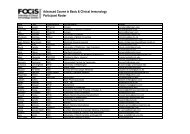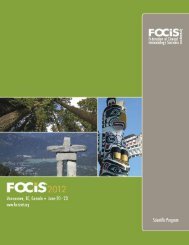Oral Presentations - Federation of Clinical Immunology Societies
Oral Presentations - Federation of Clinical Immunology Societies
Oral Presentations - Federation of Clinical Immunology Societies
Create successful ePaper yourself
Turn your PDF publications into a flip-book with our unique Google optimized e-Paper software.
S38 Abstracts<br />
Detroit, MI, Kimberly Milkovich, Research Associate,<br />
Division <strong>of</strong> Rheumatology, Case Western Reserve University,<br />
Cleveland, OH, Benig Rodriguez, Assistant Pr<strong>of</strong>essor, Center<br />
for AIDS Research, Case Western Reserve University,<br />
Cleveland, OH, Michael Lederman, Pr<strong>of</strong>essor, Case Western<br />
Reserve University, Center for AIDS Research, Cleveland,<br />
OH, Marwan Abouljoud, Director <strong>of</strong> Transplant Institute,<br />
Henry Ford Health Systems, Transplant Institute, Detroit,<br />
MI, Donald Anthony, Assistant Pr<strong>of</strong>essor, Case Western<br />
Reserve University, Division <strong>of</strong> Rheumatology and Infectious<br />
Disease, Cleveland, OH<br />
It is difficult to detect HCV-specific T cells in the peripheral<br />
blood <strong>of</strong> chronic HCV patients, while T cells specific<br />
for other viruses appear intact. One explanation for this is a<br />
compartmentalization <strong>of</strong> the immune response. Here we<br />
performed phenotypic analysis <strong>of</strong> T cells isolated from liver,<br />
perihepatic lymph nodes (LN), and peripheral blood <strong>of</strong> 23<br />
HCV infected and 12 uninfected subjects undergoing liver<br />
transplantation. Results: HCV specific IFN-γ and proliferative<br />
responses were commonly observed in the LN <strong>of</strong> HCV infected<br />
subjects (40% and 46% respectively), while they were<br />
uncommonly observed in the peripheral blood and liver<br />
(IFN-γ 16% and 25% respectively; proliferation 11% and 8%<br />
respectively). In contrast, CMV specific IFN-γ producing<br />
responses were not as commonly observed in the LN (30%)<br />
compared to the periphery (58%) and liver (60%) <strong>of</strong> these<br />
same HCV patients. Conclusions: These data are among the<br />
first to look at HCV-specific responses in perihepatic lymph<br />
nodes. The data indicate a selective defect in HCV, but not<br />
CMV specific, T cell effector function in the periphery <strong>of</strong><br />
chronic HCV patients. The relatively common presence <strong>of</strong><br />
HCV-reactive T cells in the LN is consistent with T cell<br />
activation at this site. Finally, we do not detect HCVspecific<br />
T cells more readily in the liver compared to the<br />
periphery or LN, indicating that hepatic lymphocytes are<br />
defective in effector function similar to those in the<br />
peripheral blood. The frequency <strong>of</strong> HCV-specific T cells did<br />
not clearly correlate with the severity <strong>of</strong> recurrent HCV<br />
after transplant.<br />
doi:10.1016/j.clim.2007.03.284<br />
F.72 Carbohydrate Analysis <strong>of</strong> HIV Envelope<br />
Glycoprotein<br />
Ingrid D. Cruzado-Park, Senior Development Scientist,<br />
Beckman Coulter, Inc. Fullerton, CA, Munir Alam, Duke<br />
University Medical Center, Durham, NC, Hua-Xin Liao, Duke<br />
University Medical Center, Durham, NC, Barton Haynes,<br />
Director, Duke University Medical Center, Human Vaccine<br />
Institute and CHAVI, Durham, NC, Heather Desaire, Duke<br />
University Medical Center, Durham, NC, Enrique Rabelli,<br />
Director, Custom BioPharma Solutions, Beckman Coulter,<br />
Inc. Miami, FL, Sybil D’Costa, Staff Advanced Research<br />
Scientist, Beckman Coulter, Inc. Miami, FL, Michael H.<br />
Simonian, Manager, Biomarker Discovery and Automation<br />
Center, Beckman Coulter, Inc. Fullerton, CA, Chitra K.<br />
Ratnayake, Team Leader, Beckman Coulter, Inc. Biomarker<br />
Applications and Chemistry Development, Fullerton, CA<br />
To date over 65 million people have been infected with the<br />
human immunodeficiency virus (HIV) which continues to<br />
claim several million lives a year. There is an urgent need to<br />
design and develop vaccines that generate broad neutralizing<br />
antibody enabling preventative vaccination strategies.<br />
Although the virus has evolved to circumvent the immune<br />
response, for example, carbohydrates on the envelope<br />
glycoprotein <strong>of</strong> HIV serve as a strong defense against antibody<br />
mediated responses, there is evidence that these oligomannose<br />
components can also serve as ideal vaccine candidates<br />
due to their ability to generate efficacious neutralizing<br />
antibodies in HIV infected individuals (2G12 antibody) albeit<br />
infrequently. To address the role <strong>of</strong> glycosylation in HIV<br />
pathogenesis and immunogenicity, carbohydrate pr<strong>of</strong>iles<br />
from wild type and consensus modeled, genetically engineered<br />
envelope glycoproteins were compared. We present<br />
data showing the N-linked oligosaccharide pr<strong>of</strong>iles for two<br />
types <strong>of</strong> HIV gp140 envelope glycoproteins; JRFL is a primary<br />
isolate and the other from a genetically engineered strain<br />
containing a consensus sequence (ConS), which is more<br />
effective at eliciting neutralizing antibodies. Following<br />
treatment with PNGase F, released N-linked oligosaccharides<br />
were labeled with fluorescent 8-aminopyrene-1,3,6-trisulfonate<br />
and pr<strong>of</strong>iled using the ProteomeLab PA 800 Protein<br />
Characterization System with laser-induced fluorescence<br />
(LIF) detection (488 nm excitation, 520 nm emission). We<br />
observed significant differences in the carbohydrate pr<strong>of</strong>iles<br />
<strong>of</strong> these gp140 envelopes and will present and discuss those<br />
differences. This strategy for oligosaccharide characterization<br />
and subsequent identification may help evaluate role <strong>of</strong><br />
glycosylation in generating broadly neutralizing antibody<br />
responses and enable intelligent design <strong>of</strong> carbohydratebased<br />
epitope vaccines.<br />
doi:10.1016/j.clim.2007.03.285<br />
F.73 Defining the Role <strong>of</strong> BmIL-5 in Tropical<br />
Pulmonary Eosinophilia<br />
Sung (Steve) Kwon, University <strong>of</strong> Illinois College <strong>of</strong> Medicine<br />
at Rockford, Rockford, IL, Gnanasekar Munirathinam,<br />
University <strong>of</strong> Illinois College <strong>of</strong> Medicine at Rockford,<br />
Rockford, IL, Anand Setty Balakrishnan, University <strong>of</strong> Illinois<br />
College <strong>of</strong> Medicine at Rockford, Rockford, IL, Ramaswamy<br />
Kalyanasundaram, University <strong>of</strong> Illinois College <strong>of</strong> Medicine<br />
at Rockford, Rockford, IL<br />
This study describes characterization <strong>of</strong> a novel pathogenderived<br />
human IL-5 receptor binding molecule designated<br />
BmIL-5. This molecule was identified in our laboratory by<br />
screening a phage displayed cDNA expression library <strong>of</strong> the<br />
infective larvae <strong>of</strong> the human lymphatic filarial parasite,<br />
Brugia malayi. Soluble human IL-5 receptor (huIL-5R) was<br />
used as the bait. This screening procedure yielded a single<br />
clone and sequence analyses <strong>of</strong> the insert from this clone<br />
showed a novel protein designated as “B. malayi-derived IL-<br />
5-like molecule” (BmIL-5). Recombinant BmIL-5 was then<br />
expressed and purified. ELISA-based binding assays confirmed<br />
binding <strong>of</strong> rBmIL-5 to huIL-5R. Functional significance<br />
<strong>of</strong> this binding was then evaluated using a human eosinophil<br />
cell line, named Hs 454.T. Initial studies showed that BmIL-5




